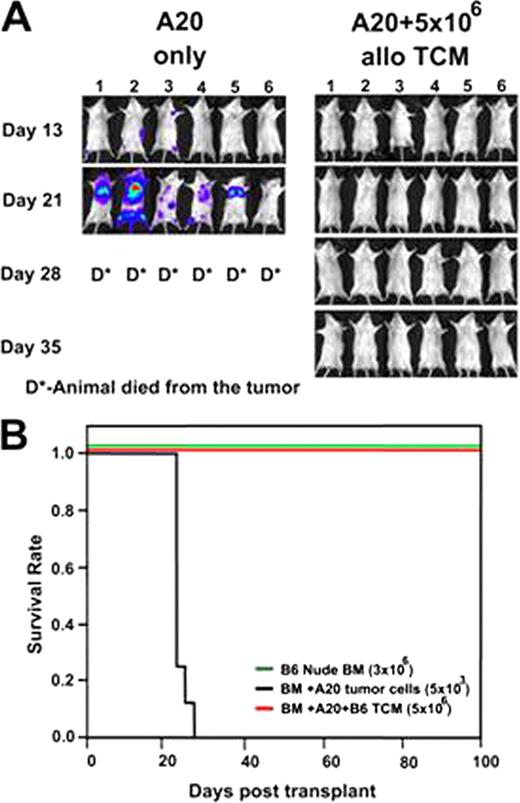Abstract
Abstract 424
Generation of T cells endowed with graft versus leukemia (GVL) and depleted of graph versus host (GVH) activity represents a highly desirable goal in BM transplantation (BMT). Donor CTLs directed against 3rd party stimulators were shown to effectively enhance engraftment of BM allografts without causing GVHD. Recently, we demonstrated that activated anti 3rd party CD8 cells with central memory phenotype (Tcm), can further support and improve BM engraftment. This is likely due to the improved lymph node homing of the Tcms, their proliferative capacity and prolonged persistence in BMT recipients. Surprisingly, when tested in vitro, anti 3rd party human CTLs were found to eliminate B CLL and other lymphoma cell types. Investigating the mechanism of the cytotoxicity revealed a unique TCR independent effect mediated against both autologous and allogeneic targets. Inhibition studies using specific blocking Ab revealed initial binding of CTLs to their targets via a rapid ICAM1-LFA1 adhesion, followed by slow induction of apoptosis following interaction of the CD8 on the CTL with MHCI on the tumor cell. The killing did not involve classical CTL death molecules. To establish an appropriate mouse model, we initially verified that anti 3rd party Tcm derived from (B6xBALB/c)F1 exhibit TCR independent killing of A20 lymphoma cells of BALB/c origin (34.8±12.1% in 4 experiments, 5:1 Tcm/lymphoma cell ratio, in comparison to A20 cells incubated without Tcm, p<0.05). Moreover, after 16 hours of incubation with Tcm, AnnexinV staining of A20 cells was enhanced compared to basal staining (14.8±4.5% and 5.2±2.2% respectively, in three experiments, p<0.05), suggesting an apoptosis based mechanism as previously described for the killing of human lymphoma. Using luciferase expressing A20 cells, we were able to follow the fate of the malignant cells in vivo, and study the effect of added donor anti 3rd party Tcm to either syngeneic or allogeneic BMT in a model simulating minimal residual disease. In the syngeneic model, 3×106 Nude BALB/c BM cells were transplanted into lethally irradiated BALB/c mice together with 5000 A20 cells. On the next day, syngeneic Tcm were infused. As can be seen in Fig. 1, none of the untreated mice survived (0/7) 100 days post BMT (23 days median survival). Administration of 1×107 or 2×107 syngeneic Tcms led to significantly diminished tumor burden (Fig. 1A) and improved overall survival of 28% (2/7, P<0.0001) and 40% (2/5, P<0.002) with median survival of 49 and 80 days, respectively (Fig. 1B). As expected, further improvement of tumor eradication was found in the allogeneic setting, in which an additional GVL effect, mediated by residual alloreactivity in the absence of GVHD, occurred in addition to the TCR independent killing. In the allogeneic model, 3×106 allogeneic Nude B6 BM cells were transplanted together with 5000 A20 cells into lethally irradiated BALB/c mice, and mice were treated with donor type Tcm. Similar to the results in the syngeneic model, none of the untreated mice survived 100 days (0/8) (23 days median survival), while administration of 5×106 donor Tcms, led to remarkable overall survival of 100% (7/7) at 100 days post BMT (Fig. 2). Although the allogeneic Tcm displayed enhanced GVL activity compared to syngeneic Tcm, this effect was not associated with any manifestation of GVHD. Thus, as previously described, the weight and overall appearance of mice receiving allogeneic anti 3rd party Tcms were the same as that of mice in the control group, radioprotected with a transplant of Nude BM alone. Collectively, we demonstrate for the first time, by in vivo imaging the GVL reactivity of murine anti 3rd party Tcm. Considering our previous finding that anti 3rd party Tcm markedly enhance BM allografting, these results suggest that anti 3rd party Tcm can provide a ‘double supportive effect' by promoting BM engraftment, and concurrently inducing GVL reactivity without causing GVHD. Such cell therapy is highly attractive, in particular for elderly patients with B CLL and other B cell malignancies who might not tolerate aggressive conditioning.
Syngeneic anti 3rd party Tcm inhibit tumor relapse after syngeneic BM transplantation
(A) Tumor growth was monitored by weekly bioluminesence imaging (BLI); (B) Survival curves.
Syngeneic anti 3rd party Tcm inhibit tumor relapse after syngeneic BM transplantation
(A) Tumor growth was monitored by weekly bioluminesence imaging (BLI); (B) Survival curves.
Allogeneic anti 3rd party Tcm inhibit tumor relapse after allogeneic BM transplantation
(A) Tumor growth was monitored by weekly BLI; (B) Survival curves.
Allogeneic anti 3rd party Tcm inhibit tumor relapse after allogeneic BM transplantation
(A) Tumor growth was monitored by weekly BLI; (B) Survival curves.
No relevant conflicts of interest to declare.
Author notes
Asterisk with author names denotes non-ASH members.



This feature is available to Subscribers Only
Sign In or Create an Account Close Modal